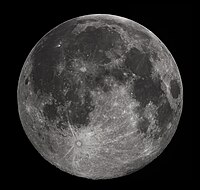
Experimental constraints on the solidification of a nominally dry lunar magma ocean
Sign Up to like & getrecommendations! Published in 2017 at "Earth and Planetary Science Letters"
DOI: 10.1016/j.epsl.2017.04.045
Abstract: The lunar magma ocean (LMO) concept has been used extensively for lunar evolution models for decades, but to date the full cooling and crystallization path of the LMO has not been studied experimentally. Here we… read more here.
Keywords: lunar magma; lmo; magma ocean; solidification nominally ... See more keywords

Early loss, fractionation, and redistribution of chlorine in the Moon as revealed by the low-Ti lunar mare basalt suite
Sign Up to like & getrecommendations! Published in 2018 at "Earth and Planetary Science Letters"
DOI: 10.1016/j.epsl.2018.07.042
Abstract: Abstract The relative abundances of chlorine isotopes measured in low-Ti basalts from the Moon appear to reflect mixing between two reservoirs: One component representing the urKREEP—the final product of the crystallization of the lunar magma… read more here.
Keywords: lunar; magma ocean; chlorine; mare basalt ... See more keywords

Timescale of overturn in a magma ocean cumulate
Sign Up to like & getrecommendations! Published in 2019 at "Earth and Planetary Science Letters"
DOI: 10.1016/j.epsl.2019.03.037
Abstract: Abstract The formation and differentiation of planetary bodies are thought to involve magma oceans stages. We study the case of a planetary mantle crystallizing upwards from a global magma ocean. In this scenario, it is… read more here.
Keywords: convection; magma; cumulate; magma ocean ... See more keywords

Fluorine and chlorine fractionation during magma ocean crystallization: Constraints on the origin of the non-chondritic F/Cl ratio of the Earth
Sign Up to like & getrecommendations! Published in 2019 at "Earth and Planetary Science Letters"
DOI: 10.1016/j.epsl.2019.05.041
Abstract: Abstract Previous studies have reported that the relative abundances of volatile elements in the silicate Earth are non-chondritic. The abundance and distribution of volatile elements in terrestrial planets would have been predominantly controlled by planetary… read more here.
Keywords: non chondritic; volatile elements; earth; ocean crystallization ... See more keywords

Isotopic evidence for a young lunar magma ocean
Sign Up to like & getrecommendations! Published in 2019 at "Earth and Planetary Science Letters"
DOI: 10.1016/j.epsl.2019.07.008
Abstract: Abstract Mare basalt sources and ferroan anorthosite suite cumulates define a linear array on a 146Sm/144Nd versus 142Nd/144Nd isochron plot demonstrating these materials were derived from a common reservoir at 4336+31/−32 Ma. The minimum proportion… read more here.
Keywords: isotopic equilibrium; moon; magma ocean;

Incompatibility of argon during magma ocean crystallization
Sign Up to like & getrecommendations! Published in 2021 at "Earth and Planetary Science Letters"
DOI: 10.1016/j.epsl.2020.116598
Abstract: Abstract We report results from multi-anvil (MA) and laser-heated diamond anvil cell (LH-DAC) experiments that synthesize high-pressure phases, including bridgmanite, ferropericlase, stishovite, and ultramafic liquid, in the presence of an argon-rich fluid. The goal of… read more here.
Keywords: bridgmanite ferropericlase; dac experiments; magma ocean; argon concentrations ... See more keywords

Acquisition of terrestrial neon during accretion – A mixture of solar wind and planetary components
Sign Up to like & getrecommendations! Published in 2019 at "Geochimica et Cosmochimica Acta"
DOI: 10.1016/j.gca.2019.08.016
Abstract: Abstract Earth’s mantle contains Ne resembling the solar wind implanted Ne-B component in meteorites (20Ne/22NeNe-B: ∼12.7). The atmosphere, instead, displays a “planetary” signature (20Ne/22NeAtm: 9.80). We explore the parameter space of a model that explains… read more here.
Keywords: solar wind; forming impact; material; magma ocean ... See more keywords

The abundances of F, Cl, and H2O in eucrites: Implications for the origin of volatile depletion in the asteroid 4 Vesta
Sign Up to like & getrecommendations! Published in 2021 at "Geochimica et Cosmochimica Acta"
DOI: 10.1016/j.gca.2021.08.021
Abstract: Abstract We conducted a petrologic study of apatite within eight unbrecciated, non-cumulate eucrites and two monomict, non-cumulate eucrites. These data were combined with previously published data to quantify the abundances of F, Cl, and H2O… read more here.
Keywords: asteroid vesta; volatile depletion; magma ocean; abundances h2o ... See more keywords

Dynamics and stability of an iron drop falling in a magma ocean
Sign Up to like & getrecommendations! Published in 2019 at "Physics of the Earth and Planetary Interiors"
DOI: 10.1016/j.pepi.2019.02.006
Abstract: Abstract The latest stages of planetary accretion involved large impacts between differentiated bodies, hence large scale melting events. Consequently, the iron brought by the impactors sank within a deep magma ocean, before reaching the proto-core.… read more here.
Keywords: iron drop; drop; weber number; magma ocean ... See more keywords

Nebular atmosphere to magma ocean: A model for volatile capture during Earth accretion
Sign Up to like & getrecommendations! Published in 2019 at "Physics of the Earth and Planetary Interiors"
DOI: 10.1016/j.pepi.2019.106294
Abstract: Abstract The origin and abundance of mantle volatiles present major questions for Earth's evolution. Here we quantify volatile capture from an atmosphere derived from the solar nebula during accretion, using a boundary layer model of… read more here.
Keywords: volatile capture; nebular atmosphere; earth; accretion ... See more keywords

Terrestrial magma ocean origin of the Moon
Sign Up to like & getrecommendations! Published in 2019 at "Nature Geoscience"
DOI: 10.1038/s41561-019-0354-2
Abstract: A conceptual framework for the origin of the Moon must explain both the chemical and the mechanical characteristics of the Earth–Moon system to be viable. The classic concept of an oblique giant impact explains the… read more here.
Keywords: moon; magma ocean; angular momentum; origin moon ... See more keywords